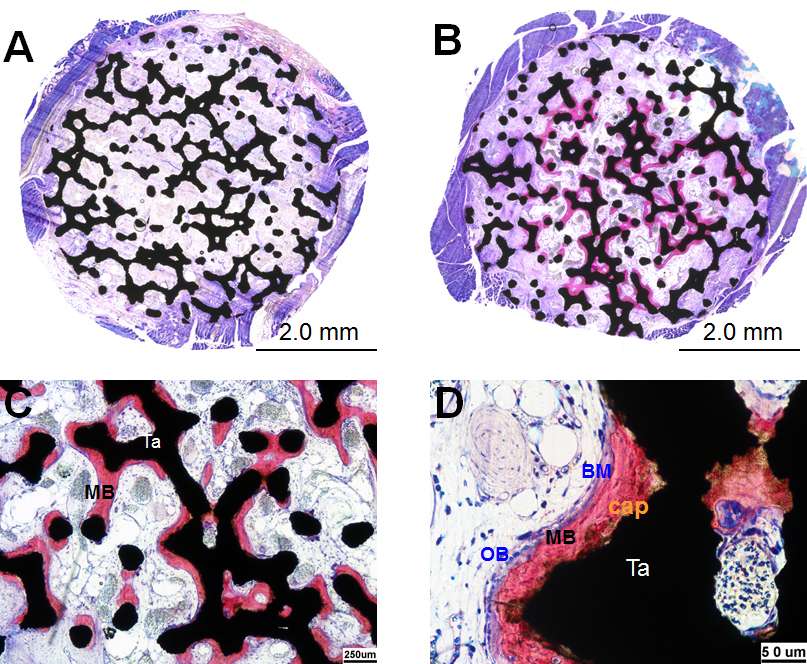Introduction: When CaP ceramics were structurally mimicking bone, they positively stimulated bone formation and became osteoinductive[1],[2]. Osteoinductive CaP ceramics could replace autologous bone graft for bone regeneration in critical-sized bone defects[3]. To overcome the brittleness of osteoinductive CaP ceramics for load-bearing application, we developed herein an osteoinductive metal implant using a biomimetic CaP coating technique.
Materials and Methods: Porous Tantalum cylinders (HedrocelTM, Implex Corporation), Φ5*10 mm with 75-80% porosity, with highly interconnected pores (600-700 μm), were coated with CaP layer. Firstly, porous tantalum cylinders were soaked in 1000 ml de-ionized watera containing 40.00 g NaCl, 1.84 g CaCl2.2H2O, 1.52 g MgCl2.6H2O, 1.06 g NaHCO3 and 0.86 g Na2HPO4.2H2O in for 24hrs.Thereafter the samples were immersed in 1000 ml de-ionized water consisting 8.00 g NaCl, 0.59 g CaCl2.2H2O and 0.36 g Na2HPO4.2H2O at pH 7.4 buffered with 50 mM TRIS-HCl. Finally the samples were rinsed with de-ionized water and dried. The morphology and the chemical composition of the CaP coating were analyzed with SEM, XRD and EDX. The Ta cylinders with and without CaP coating were implanted ectopically in thigh muscle of 8 dogs for 90 days. The explants were subjected to histological observation and hisotomorphometrical assays after PMMA embedding. BSEM was applied to the PMMA-embedded explants after polishing the cross sections and coated with carbon.
Results: SEM showed the surface of coated Ta was fully covered with a CaP layer of ACP (peripheral) and OCP (central). Bone was formed in all coated Ta implants (8 out of 8), while no bone was found in any of un-coated Ta implants (0 out of 8) (Figure 1, A&B). Mineralized bone with bone marrow-like tissue was seen in the central region of coated Ta (Figure 1C). Fibrous soft tissues were noted in centric region of un-coated Ta and peripheral region of coated Ta (Figure 1, A&B). CaP coating was also histologically observed on coated Ta, followed sequentially by mineralized bone, newly formed bone and osteoblast seam (Figure 1,D), indicating a bonding osteogenesis on CaP coating. BSEM showed a close contact between the layers of Tantalum surface, CaP coating and mineralized bone. Quantitatively 13±5% of the pores in the ccoated Ta implants was occupied by mineralized bone.

Figure 1. Tissue responses to Tantalum implants in muscle of dogs for 90 days (1% methylen blue and 0.3% basic fuchsin staining). Two histological overviews (A and B) showing bone formation in coated Ta (B) and no bone in un-coated Ta (A), a light microscopic image (C) showing the mineralized bone (MB) and bone marrow-like tissue in the central region of coated implants and an enlargement (D) showing the sequences of tantalum (Ta), CaP coating (cap), mineralized bone (MB), newly formed bone martix (BM) and osteoblast seam (OB).
Results and Discussion: By such a biomimetic technique, inner surface of porous metal implants was coated with CaP. Nevertheless, the thickness, the morphology and phase composition of the coating varied from peripheral to the central. It is not clear yet whether the missing of bone close to peripheral region of coated implants is because of the chemistry (OCP at outer surface vs ACP in the central) or the dimension of crystal size (micron scale OCP vs nano or submicron scale ACP), while it is clear that mechanically strong osteoinductive implants could be achieved with biomimetic CaP-coated metals.
References:
[1] Davison, N., X. Luo, et al. (2013). "Submicron-scale surface architecture of tricalcium phosphate directs osteogenesis in vitro and in vivo." European cells & materials 27: 281-297.
[2] Zhang, J., X. Luo, et al. (2014). "The size of surface microstructures as an osteogenic factor in calcium phosphate ceramics." Acta biomaterialia 10(7): 3254-3263
[3] Yuan, H., H. Fernandes, et al. (2010). "Osteoinductive ceramics as a synthetic alternative to autologous bone grafting." Proceedings of the National Academy of Sciences 107(31): 13614-13619.